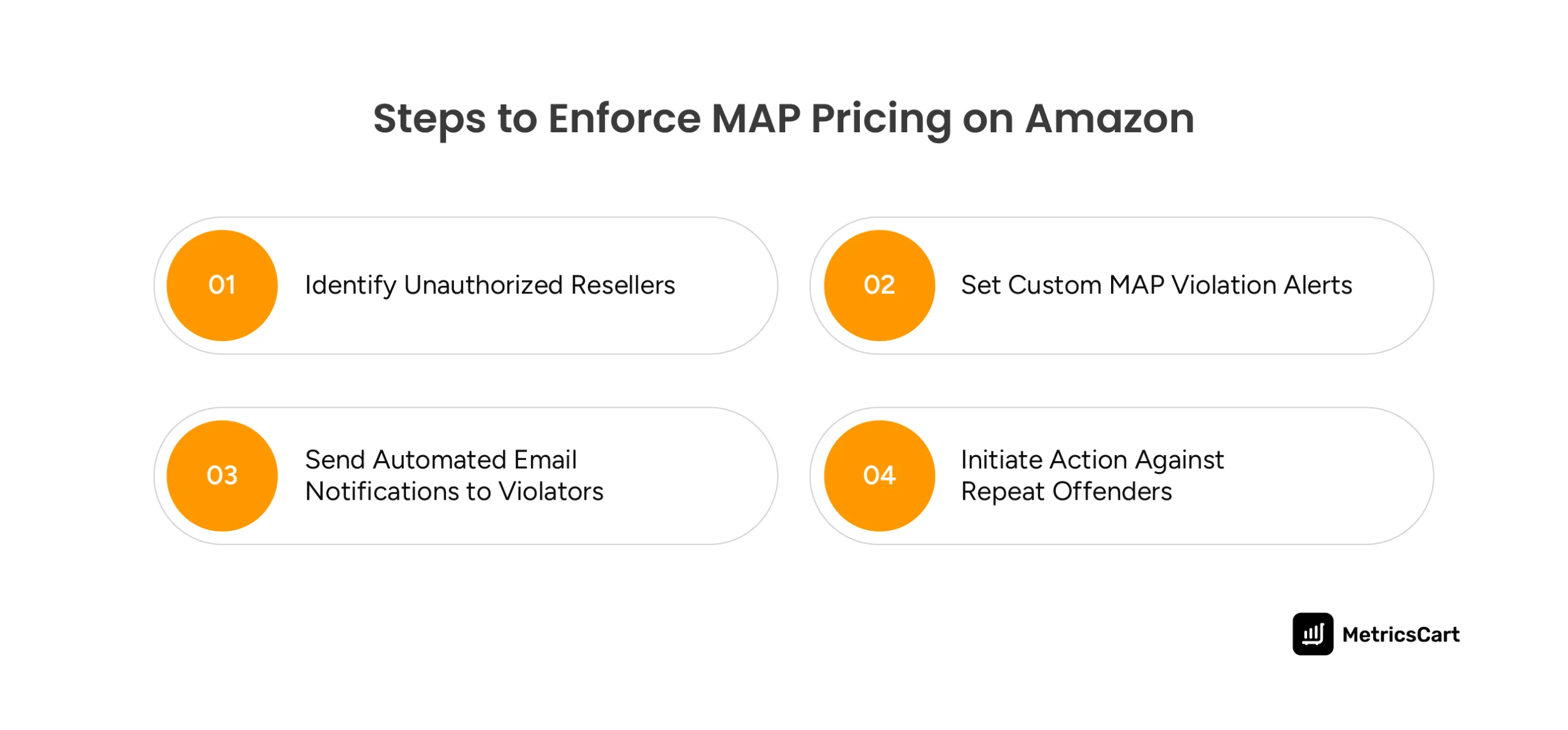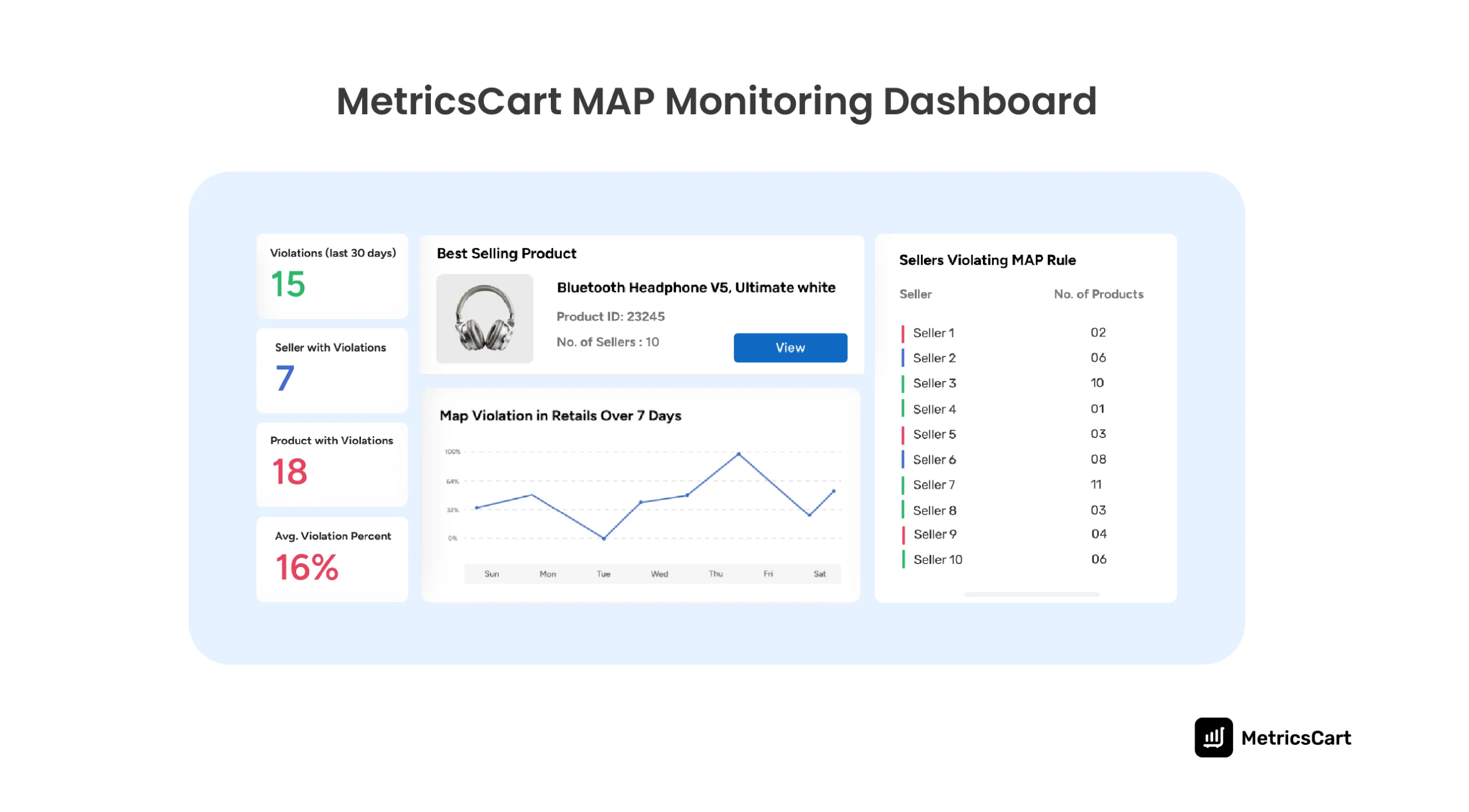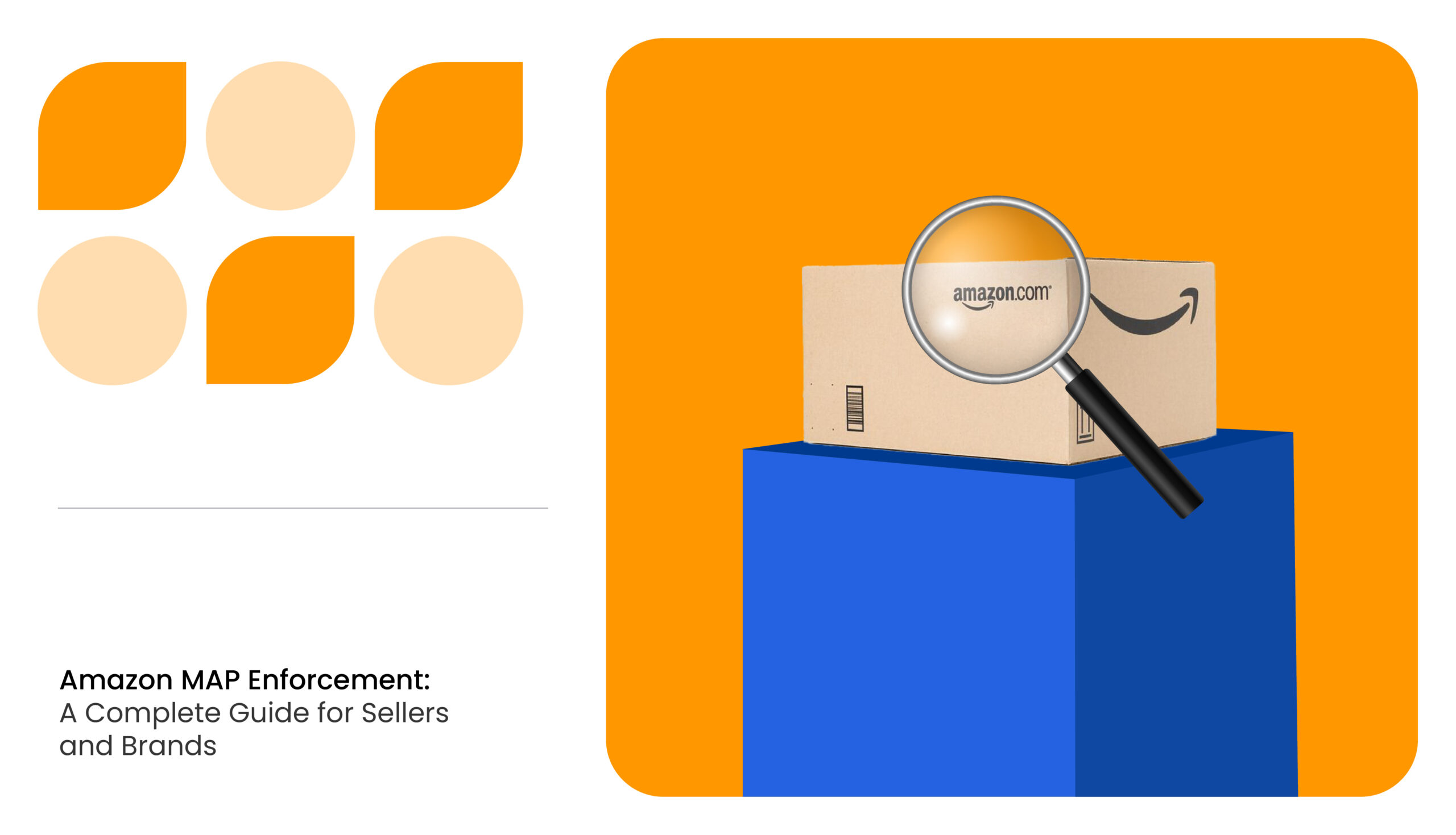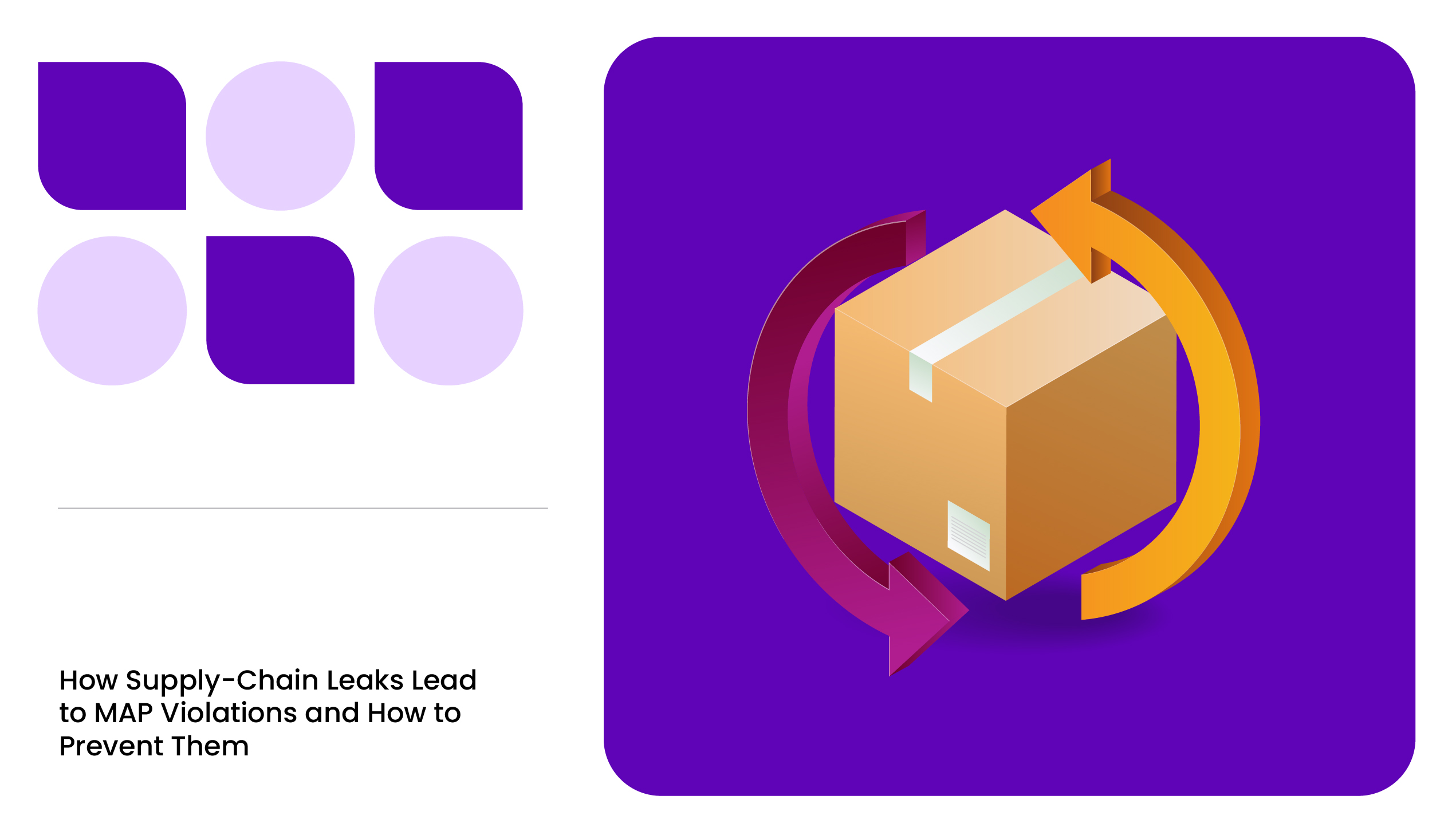If you’ve built a strong brand, the last thing you want is a random seller tanking your prices on Amazon. So, you set a Minimum Advertised Price (MAP) to keep things fair for your margins, your retail partners, and your brand image.
But enforcing that on Amazon? That’s where things get messy. Amazon won’t police your MAP policy. And between unauthorized resellers and aggressive repricing bots, your product’s price can dip below MAP before you even realize it.
That’s where MetricsCart’s MAP monitoring tool comes in. It tracks your listings 24/7, flags violations instantly, and helps you take swift action- all without manual effort.
In this guide, we’ll break down why violations happen frequently and what steps you can take to conduct Amazon MAP enforcement.
Why is Amazon Prone to MAP Violations?
Amazon’s open marketplace structure makes it especially susceptible to MAP price violations for several reasons.
Third-Party Resellers and Grey Market Activity
Amazon’s marketplace has countless independent sellers. Some unauthorized resellers obtain products through unofficial channels, such as gray-market distributors or liquidation sales, and then undercut the minimum price to win sales. This cutthroat competition can quickly lead to price erosion, harming your product’s perceived value and upsetting authorized retailers.
Dynamic Pricing
Prices on Amazon can change rapidly due to competition and the use of repricing tools. Amazon’s own pricing algorithms and third-party seller repricer software frequently adjust prices in real-time.
These dynamic fluctuations mean your product’s price could drop below MAP without you immediately noticing. The constantly changing prices make it hard to maintain consistent advertised pricing on the platform.
READ MORE | Confused about dynamic pricing? Check out Dynamic Pricing in E-Commerce: Strategies and Insights
Lack of Automatic Amazon Enforcement
Unlike some channels, Amazon does not actively enforce MAP agreements for you. Amazon views MAP as an agreement between the manufacturer and the sellers, allowing sellers to list items at any price.
This lack of automatic enforcement means that violations can occur freely unless the brand intervenes. Due to these challenges, MAP policy enforcement on Amazon necessitates a proactive approach by brands.
How to Enforce MAP Pricing on Amazon?
Enforcing MAP on Amazon requires vigilance and a strategic approach. Here are the key steps to enforce MAP on Amazon effectively:

Identify Unauthorized Resellers
Keep track of all the sellers offering your product on Amazon and determine who is authorized and who isn’t. Unauthorized third-party sellers are often the source of Amazon MAP violations, so identifying them is the first step.
Regularly audit your brand’s Amazon listings. Tools like MetricsCart can automate this by continuously scanning listings and flagging sellers who are not on your authorized list, saving you time and effort.
READ MORE | Struggling with Unauthorized Sellers on Amazon? Dive into How to Stop Unauthorized Sellers on Amazon?
Set Custom MAP Violation Alerts
Continuous monitoring is vital to enforce MAP on Amazon. Brands need to use a MAP monitoring software to watch their product listings around the clock and set up custom alerts that notify them immediately whenever a seller advertises your product below the MAP price.
This allows you to respond quickly, before a prolonged MAP violation causes widespread price erosion or angers your other retail partners. Automated MAP monitoring solutions can significantly simplify this process by emailing or texting you the moment a violation is detected.
Send Automated Email Notifications to Violators
When a violation is detected, contact the offending seller promptly. Often, a polite but firm reminder of your MAP policy is enough to resolve the issue. In many cases, a well-crafted email is enough to prompt an authorized seller to update their pricing.
You can automate these notification emails using MetricsCart. The tool offers a tiered action plan, sending automated email notices to unauthorized sellers and MAP violators, using templates that progress from reminders to final warnings.
By responding swiftly, you show the seller that you are actively monitoring and enforcing your pricing policy.

Initiate Action Against Repeat Offenders
If a seller repeatedly ignores your MAP policy, be prepared to take further action. For authorized retailers, this could mean imposing penalties per your policy or ultimately revoking their authorized dealer status if they do not comply.
For rogue third-party Amazon sellers, you may need to escalate the issue by reporting them through Amazon’s Brand Registry or Seller Central support channels.
In serious cases, brands sometimes resort to legal action or intellectual property complaints against Amazon. You can also consistently enforce consequences for violators, like cutting off supply, removing them from authorized listings, or reporting violations.
This way, persistent offenders will either fall in line or risk losing the ability to sell your products.
Conclusion
Maintaining proper pricing on Amazon is crucial for your brand’s long-term success. MAP enforcement protects your brand’s value, keeps profit margins healthy, and fosters trust with your authorized retailers.
Although Amazon’s marketplace is prone to MAP violations, a proactive approach can keep problems in check. By closely monitoring prices and addressing issues quickly, especially with the help of automation tools like MetricsCart, even small brands can effectively enforce their pricing policies.

In the end, consistent Amazon MAP enforcement will preserve a fair competition on Amazon’s marketplace, helping your brand thrive while keeping its reputation and relationships intact.
Struggling to enforce MAP across channels?
FAQs
MAP stands for Minimum Advertised Price. It is the lowest price a brand or manufacturer allows its product to be advertised at. A MAP policy prevents retailers from undercutting each other with extreme discounts. This helps protect the brand’s image, maintain fair competition, and preserve profit margins.
Amazon generally does not enforce MAP policies for sellers. MAP agreements are considered a matter between the brand (manufacturer) and the sellers. This means Amazon won’t automatically stop a seller from listing below MAP. It’s the responsibility of the brand to monitor and enforce MAP compliance on Amazon.
o enforce MAP pricing on Amazon, start by monitoring your product prices regularly. Identify any sellers who are advertising below your MAP and record their details. Then, send those sellers a friendly but firm message reminding them of your MAP policy and asking them to raise the price to at least the minimum.
When a seller violates your MAP policy, the first step is usually to notify them and request compliance. Many authorized sellers will correct the price once they’re reminded, since they value the relationship. However, if a seller ignores the warning or is a repeat offender, there can be consequences.
MetricsCart is a software solution designed to automate Amazon MAP monitoring and enforcement. It continuously scans your Amazon listings and sends instant alerts if any seller lists your product below the minimum price.







